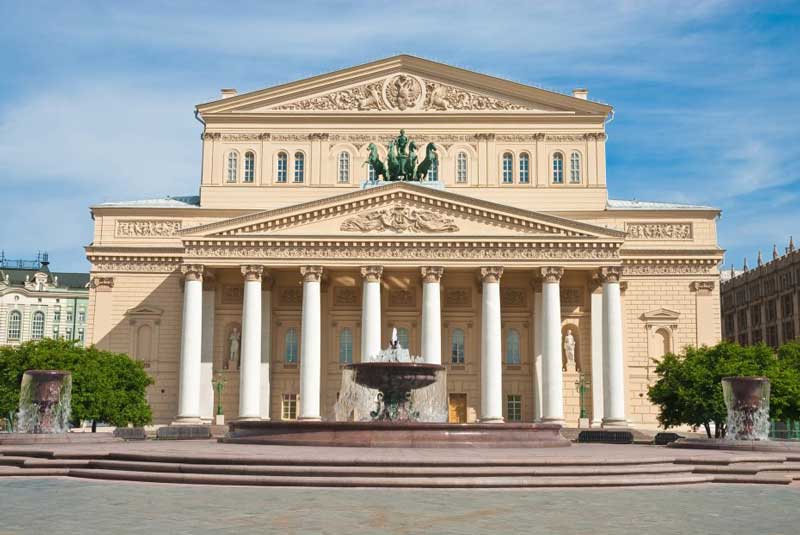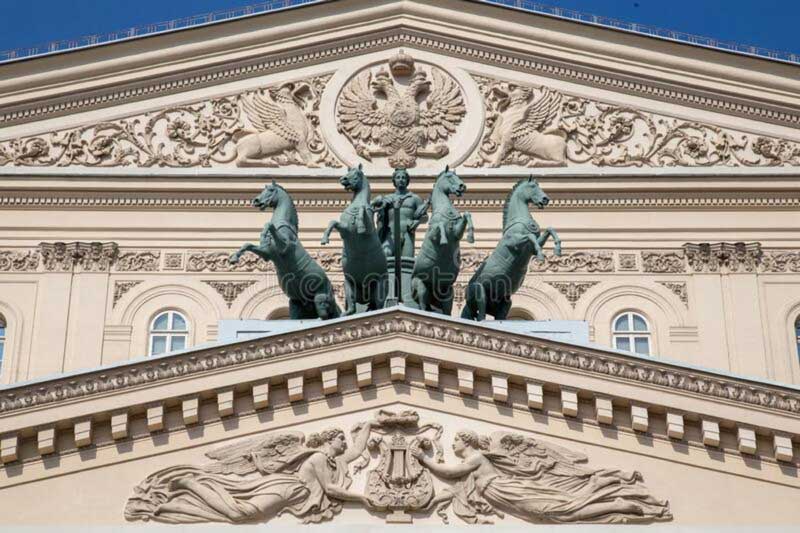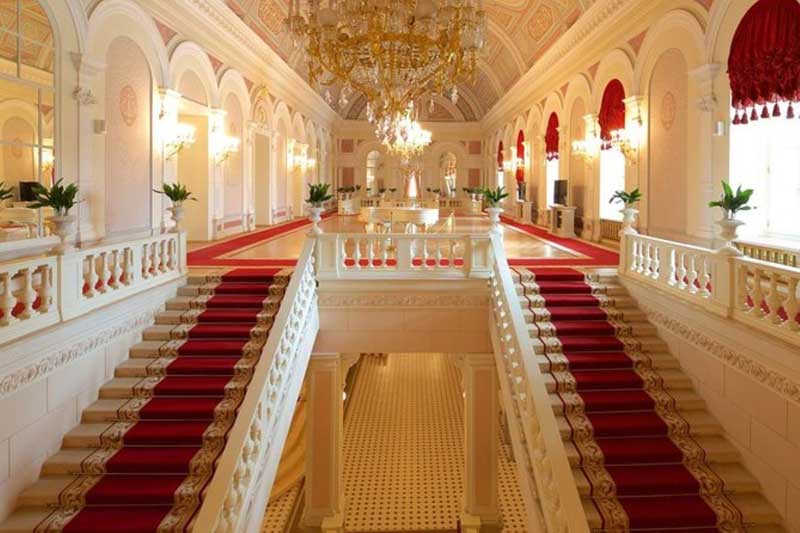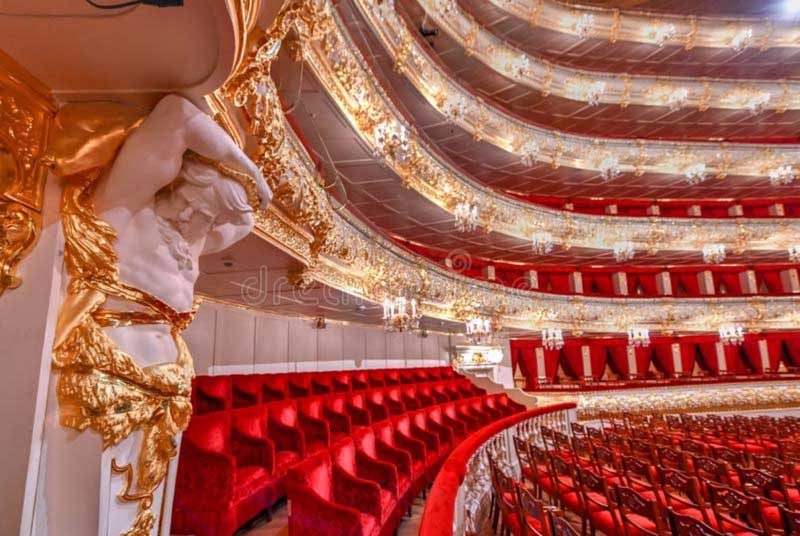
The history of the famous Bolshoi Theatre, officially named State Academic Bolshoi Theatre of Russia, the leading theatre company for ballet and opera in Russia, began its journey on 28 March 1776, when Empress Catherine II signed and granted the privilege to the Moscow prosecutor Prince Pyotr Urusov of organizing theatre performances, masquerades, balls and other forms of entertainment for ten years. Initially, Urusov formed a single opera and dramatic troupe company, made up of several smaller troupes, in collaboration with a mathematician, tightrope-walker and English theatrical entrepreneur Michael Maddox, performing primarily at the mansion of Count R.I. Vorontsov.
The first building of the theatre company was erected on Petrovka Street, on the right bank of the River Neglinka, in a record time of less than six months and the new Petrovsky Theatre, named after the street on which it stood, opened its doors on 30 December 1780, producing plays and operas with both professional and serf actors listed in its troupe. However, before the Petrovsky Theatre School was reorganized into the Moscow Imperial Theatre College for the training of opera, ballet and theatre artists and theatre orchestra musicians in 1806, a devastating fire destroyed the Petrovsky Theatre building on 8 October 1805. As if that was not enough, the New Arbat Imperial Theatre, designed by Carlo Rossi, which replaced the Petrovsky Theatre on 13 April 1808, also succumbed to fire during the French invasion of Moscow in 1812.

After that, a competition for designs for a new theatre held in 1819 was won by Andrei Mikhailov, a professor at the Academy of Arts, but as it was deemed too costly to complete, architect Joseph Bové was commissioned to alter it, which the latter did considerably, by improving it in the process. The building for the theatre was built between 1821 and 1824 and the new building was opened on 6 January 1825 as the Bolshoi Petrovsky Theatre with a performance of a ballet Cendrillon, produced by a guest ballerina and ballet-master from France, Félicité Hullen-Sor and music by the latter’s husband, Fernando Sor. However, although the building was quite big, a large-scale project for reconstruction to make it bigger was undertaken in 1843, according to a design by A. Nikitin.
The renovated building of the Bolshoi Petrovsky Theatre stood proudly for almost 30 years, until 11 March 1853, when a fire broke out in the building, which continued for three days and destroyed everything, except the charred stone walls and portico columns. After the demolition and clearing away of the ruins, the reconstruction of a new building began in May 1855, under the leadership of Alberto Cavos, chief architect of the imperial theatres and a professor of the Petersburg Academy of the Arts and the rebuilt building, enlarged to accommodate an audience of more than 2,000, opened its door to the public on 20 August 1856, just in time for the coronation celebrations of Emperor Alexander II. Despite its various disasters and pitfalls, it is basically the structure of the Bolshoi that still stands today.

The overall height of the new building of the Bolshoi was increased by almost 13 feet (4 m) and despite the original portico columns were saved from the ravaging fire, the main facade underwent a fundamental change, in which a second pediment was created and the troika-led chariot of Apollo was replaced by a quadriga, cast in bronze. The tympanum or the inner field of the pediment was decorated with an alabaster bas-relief depicting winged geniuses with lyre.
While the frieze and capitals of the columns were altered, the sloping roofs on cast iron pillars were erected over the side facade entrances of the theatre. Inside the building, the accommodation of the magnificent crimson-gold, six-tier auditorium was increased to almost 2300 people. While the lettered boxes closest to the stage on both sides of the auditorium were reserved for the Tsar's family and the other dignitaries, the Tsar's box, opposite the stage and protruding a little into the auditorium was supported by consoles in the form of bent Atlantes at the bottom. The wicks of the beautiful auditorium chandelier, composed of 300 oil lamps, had to be lit by hand from a secret opening in the circular ceiling and the secret opening was hidden by the circular composition of the mural, depicting Apollo and the Muses, painted by Alexei Titove. However, in the mural, the artist replaced Polyhymnia, one of the canonic muses of the sacred hymn, poetry, dance and eloquence, by depicting a muse of his own invention, the muse of painting, with a palette and a brush in her hands. The Beethoven Room, located in the area behind the stage and used in the past as an imperial foyer, is decorated with beautiful stuccoes on the ceiling, made up of 3,000 rosettes, while the walls are embellished with carefully embroidered red silk panels.

Nevertheless, the Bolshoi became famous as one of the best theatres in the world in terms of its acoustic qualities in the second half of the 19th century, thanks to the specialized skill of Alberto Cavos, who designed the entire auditorium as a huge musical instrument, the walls of which were lined with acoustically resonant pine wood panels, the iron ceiling was replaced by a wooden one and the painted plafond, or the decorated ceiling, was constructed out of wooden panels. The decoration of the boxes made out of papier-mâché, a malleable mixture of paper or flour and glue, also geared to the acoustics and for the further improvement of the acoustics, Cavos filled in the space occupied by a cloakroom, located under the amphitheatre.


Strangely enough, following the October Revolution, not only its foundations, but the very existence of the Theatre also came under threat of demolition, as it was seen as an example of the aristocratic entertainment by Lenin and on 12 December 1917, there was even an unsuccessful attempt to shut the institution entirely. But ultimately, the good sense prevailed, when authorities, in the shape of the victorious proletariat, gave up their idea of shutting down the Bolshoi Theatre and renamed it The State Academic Bolshoi Theatre. However, as the condition of the building was found to be catastrophic, the Bolshevik government decided to undertake emergency repairs under the direction of architect Ivan Rerberg. During that time, apart from the reinforcement of the foundations under the semi-circular auditorium walls, the cloakrooms were overhauled, the staircases were rearranged and new rehearsal rooms and dressing rooms were also created. Ridiculously, in 1922, the Bolshevik government used the historic building for their party purposes, like holding the meetings of The All-Russian Congresses of Soviets, the All-Russian Central Executive Committee sessions and other meetings and conferences of the party, even the formation of a new country, the USSR, was proclaimed from the stage of the Bolshoi Theatre.

But in April 1941, the Bolshoi Theatre building was closed again for renovation and just two months later, the Germans invaded the USSR. It was on 22 October 1941, when a bomb fell on the building at 4 pm, when the shock wave passed obliquely between the portico columns and went through the facade wall, damaging the lobby considerably. But despite the wartime hardship and the severe cold, restoration work on the Theatre was initiated in the winter of 1942 and by autumn 1943, the Bolshoi Theatre had again opened its doors to the public with a production of an opera, named A Life for the Tsar, composed by Mikhail Glinka. In recent times, the theatre was closed for restoration and renovation from July 2005 to October 2011, when the process of improvement in the acoustics of the theatre included the attempt to restore the original sound quality believed to have existed in pre-Soviet times as well as the restoration of the original Imperial décor of the theatre. As an iconic structure of Russia, the Bolshoi has taken on varied significance throughout the history of the country, as it has been with the country every step of its history for more than 150 years.